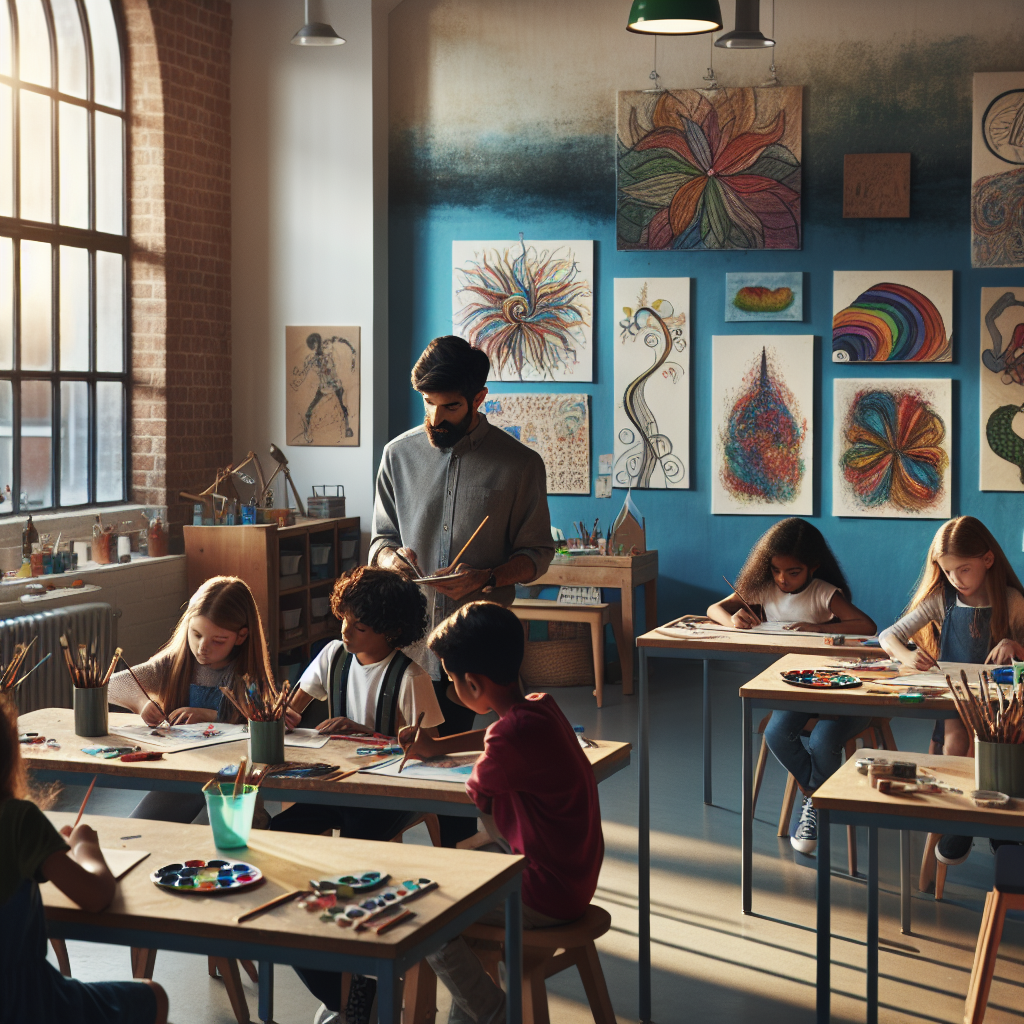Mở bài
Chủ đề Importance Of Art Education For Fostering Creativity xuất hiện thường xuyên trong IELTS Writing Task 2 bởi tính thời sự của giáo dục sáng tạo và tranh luận về vị trí của môn Nghệ thuật trong nhà trường. Trong bài viết này, bạn sẽ học được: 3 bài mẫu từ Band 5 đến Band 9, phân tích chấm điểm chi tiết theo 4 tiêu chí chính thức, bộ từ vựng chuyên sâu, 6 cấu trúc câu ghi điểm cao, cùng checklist thực hành nhanh. Tôi cũng chỉ ra lỗi thường gặp của thí sinh Việt Nam và cách khắc phục thực tế.
Nội dung bài viết
- Mở bài
- 1. Đề Bài và Phân Tích
- 2. Bài Mẫu Band 8-9
- Phân Tích Band Điểm
- Tại Sao Bài Này Đạt Điểm Cao
- 3. Bài Mẫu Band 6.5-7
- Phân Tích Band Điểm
- So Sánh Với Bài Band 8-9
- 4. Bài Mẫu Band 5-6
- Phân Tích Band Điểm
- Học Từ Những Lỗi Sai
- Cách Cải Thiện Từ Band 6 Lên Band 7
- 5. Từ Vựng Quan Trọng
- 6. Cấu Trúc Câu Điểm Cao
- 7. Checklist Tự Đánh Giá
- Kết bài
Một số câu hỏi Task 2 đã được ghi nhận bởi các nguồn đáng tin cậy:
- “Some people think that art is an essential subject for children at school, while others think it is a waste of time. Discuss both views and give your opinion.” (được tổng hợp trên IELTS Liz và IELTS-Blog)
- “Art classes such as painting and drawing are important for children’s development and should be compulsory in the school curriculum. To what extent do you agree or disagree?” (được báo cáo bởi IELTS-Blog; chủ đề tương tự cũng xuất hiện trong tuyển tập đề của British Council/IDP)
- “Some people believe governments should fund the arts in schools; others say money should go to core subjects. Discuss both and give your opinion.” (xuất hiện trong các tổng hợp đề chủ đề Education & Arts)
Trong bài này, tôi chọn đề thứ hai để phân tích chuyên sâu vì bám sát ý định tìm kiếm: importance of art education for fostering creativity, giúp bạn xây dựng lập luận mạnh về vai trò của nghệ thuật trong nuôi dưỡng sáng tạo. [internal_link: cách phân tích đề Task 2 theo từ khóa]
1. Đề Bài và Phân Tích
Art classes such as painting and drawing are important for children’s development and should be compulsory in the school curriculum. To what extent do you agree or disagree?
Dịch đề: Các lớp học nghệ thuật như vẽ và hội họa quan trọng đối với sự phát triển của trẻ và nên là môn bắt buộc trong chương trình học. Bạn đồng ý hay không đồng ý đến mức độ nào?
Phân tích đề bài:
- Dạng câu hỏi: Opinion (To what extent do you agree or disagree?). Bạn cần đưa ra quan điểm rõ ràng, có thể hoàn toàn đồng ý/hoàn toàn phản đối hoặc đồng ý một phần, nhưng phải nhất quán toàn bài.
- Từ khóa: art classes, children’s development, compulsory, school curriculum. “Compulsory” = bắt buộc; “development” bao gồm nhận thức, cảm xúc, xã hội, và đặc biệt là sự sáng tạo.
- Lỗi thường gặp:
- Lệch trọng tâm sang “ngân sách nghệ thuật” hoặc “nghệ sĩ chuyên nghiệp” thay vì “nghệ thuật trong trường phổ thông”.
- Định nghĩa “phát triển” quá mơ hồ; thiếu ví dụ giáo dục cụ thể (studio work, project-based learning, divergent thinking).
- Dùng từ vựng chung chung như good/important; thiếu collocations học thuật (nurture creativity, transferable skills, aesthetic sensibility).
- Cách tiếp cận chiến lược:
- Lập luận chính: nghệ thuật nuôi dưỡng tư duy phân kỳ và sự sáng tạo áp dụng liên môn (transferable), hỗ trợ sức khỏe tinh thần và hòa nhập; phản biện về áp lực thời khóa biểu bằng giải pháp tích hợp.
- Dẫn chứng: ví dụ lớp học cụ thể (portfolio projects, collaborative murals), kỹ năng chuyển giao (problem-solving, resilience).
 Tầm quan trọng giáo dục nghệ thuật nuôi dưỡng sáng tạo trong IELTS Task 2
Tầm quan trọng giáo dục nghệ thuật nuôi dưỡng sáng tạo trong IELTS Task 2
2. Bài Mẫu Band 8-9
Bài Band 8-9 cần có lập luận sâu, ví dụ cụ thể, mạch lạc cao, từ vựng học thuật chính xác và ngữ pháp đa dạng.
Bài luận (298 từ):
It is often claimed that art classes are a luxury, yet few would deny the pivotal role they play in a child’s growth. I strongly agree that they should be compulsory because they cultivate creativity and transferable competencies that mainstream subjects alone cannot provide. Not only does art education build imaginative capacity, but it also strengthens problem-solving through iterative experimentation.
To begin with, art nurtures divergent thinking—the ability to generate multiple solutions to a single problem. In a painting project, for instance, children must negotiate constraints of color, texture, and composition, thereby practising design thinking in authentic contexts. Art education, which is often sidelined, in fact develops aesthetic sensibility and emotional literacy, enabling students to communicate nuance when words fail. These capacities spill over into science and languages, where students who have trained their visual-spatial and metaphorical reasoning frequently devise more original hypotheses and arguments.
A second reason is inclusion. Because success in art is not tied to a single “right” answer, mixed-ability classrooms can thrive. Group murals or portfolio critiques demand collaboration, persistence, and constructive feedback—the very soft skills most valued by universities and employers. It is through sustained practice that children learn to tolerate uncertainty and refine their ideas, a habit of mind essential to innovation.
Critics contend the curriculum is already overloaded. While this is a legitimate concern, the solution is not to cut arts but to integrate them. If art were marginalised, schools would forfeit a uniquely effective vehicle for fostering creativity. Cross-curricular projects—such as visualising data through infographics in science—preserve instructional time while amplifying learning.
In short, making art compulsory is not about producing painters; it is about safeguarding the importance of art education for fostering creativity and the broader, portable skills it yields. Only by embedding the arts can schools prepare adaptable, inventive citizens.
Phân Tích Band Điểm
| Tiêu chí | Band | Nhận xét |
|---|---|---|
| Task Response (Hoàn thành yêu cầu) | 8.5 | Trả lời trực tiếp, quan điểm rõ ràng và nhất quán. Lý do chính mạnh (sáng tạo, kỹ năng chuyển giao, hòa nhập), có phản biện và giải pháp tích hợp. Ví dụ cụ thể cấp lớp học. |
| Coherence & Cohesion (Mạch lạc & Liên kết) | 8.5 | Mở–Thân–Kết rõ; mỗi đoạn có topic sentence và phát triển logic. Dùng cohesive devices tinh tế (To begin with, A second reason, While…, In short). Liên kết ý theo nguyên nhân–hệ quả. |
| Lexical Resource (Từ vựng) | 8.5 | Từ vựng học thuật đa dạng: divergent thinking, aesthetic sensibility, emotional literacy, iterative experimentation, cross-curricular. Collocations tự nhiên; hầu như không lặp từ. |
| Grammatical Range & Accuracy (Ngữ pháp) | 8.0 | Đa dạng cấu trúc: mệnh đề quan hệ không xác định, đảo ngữ, câu điều kiện giả định, mệnh đề phụ thuộc. Chính xác cao, không lỗi đáng kể. |
Tại Sao Bài Này Đạt Điểm Cao
- Luận điểm bám sát keyword “importance of art education for fostering creativity” và triển khai theo hướng transferable skills.
- Dẫn chứng lớp học cụ thể (painting project, group murals, portfolio critiques) giúp thuyết phục.
- Có phản biện và giải pháp tích hợp thay vì bác bỏ đơn thuần.
- Sử dụng cấu trúc nâng cao: đảo ngữ “Not only does…”, mệnh đề quan hệ không xác định, câu điều kiện loại II.
- Từ vựng học thuật chuẩn và chính xác về ngữ nghĩa, collocations tự nhiên.
- Kết luận quay lại chủ đề, nhấn mạnh năng lực thích ứng và sáng tạo.
- Giọng văn điềm tĩnh, cân bằng, tránh tuyệt đối hóa.
3. Bài Mẫu Band 6.5-7
Đặc điểm: Ý rõ, có ví dụ, mạch lạc tốt nhưng còn lặp từ, một số collocation chưa tự nhiên, ngữ pháp chủ yếu đúng nhưng chưa thật đa dạng.
Bài luận (265 từ):
Many people argue that art classes are less important than core subjects, but I believe they should be compulsory because they help children think creatively and work better with others. First, the arts encourage students to look for more than one answer. When children try to finish a drawing, they must choose colours, shapes and layout. This process trains their brains to explore options rather than accept a single solution, which can later support problem-solving in science or even maths.
Second, art is motivating for different types of learners. Some students are not confident in tests, but they can express themselves through painting or design. In group projects, they learn to share ideas, give feedback and be patient, which are useful skills for school and future jobs. If schools ignore art, many students may lose the chance to build confidence and discover their talents.
However, the curriculum is already busy. In my view, the answer is to integrate art with other subjects rather than add more hours. For example, making posters to present science topics or drawing storyboards in literature classes can save time while keeping creativity alive. This approach shows the importance of art education for fostering creativity without putting extra pressure on teachers and students.
In conclusion, art classes should be compulsory because they develop creative thinking and social skills. With smart integration, schools can protect arts education and still focus on academic results.
Phân Tích Band Điểm
| Tiêu chí | Band | Nhận xét |
|---|---|---|
| Task Response (Hoàn thành yêu cầu) | 7.0 | Quan điểm rõ, có lý do và ví dụ phù hợp; có nhắc đến phản biện quá tải chương trình và giải pháp tích hợp. Chưa đi sâu khía cạnh “inclusion”/“emotional literacy”. |
| Coherence & Cohesion (Mạch lạc & Liên kết) | 7.0 | Bố cục hợp lý; dùng từ nối cơ bản. Một số ý chuyển hơi nhanh, thiếu câu kết đoạn nhấn mạnh. |
| Lexical Resource (Từ vựng) | 6.5 | Từ vựng đủ dùng; có cụm tốt (problem-solving, integrate), nhưng còn lặp “art”, “creativity”. Thiếu một số collocations học thuật nâng cao. |
| Grammatical Range & Accuracy (Ngữ pháp) | 7.0 | Chủ yếu chính xác; có câu điều kiện, mệnh đề quan hệ đơn giản. Ít cấu trúc phức tạp, chưa có đảo ngữ/câu chẻ. |
So Sánh Với Bài Band 8-9
- Chiều sâu luận điểm: Band 8-9 có “divergent thinking, emotional literacy, inclusion, iterative experimentation” rõ ràng hơn; bài 6.5-7 diễn giải tổng quát.
- Ngôn ngữ: Band 8-9 dùng collocations học thuật chính xác, 6.5-7 dùng từ chung và lặp.
- Ngữ pháp: 8-9 có đảo ngữ, câu điều kiện giả định, mệnh đề quan hệ không xác định; 6.5-7 chủ yếu câu đơn/câu ghép.
- Phản biện: 8-9 đưa giải pháp tích hợp kèm ví dụ liên môn; 6.5-7 có, nhưng chưa giàu chi tiết.
4. Bài Mẫu Band 5-6
Đặc điểm: Ý còn chung chung, ví dụ mờ nhạt, từ vựng đơn giản, xuất hiện lỗi ngữ pháp (mạo từ, chia thì, giới từ), liên kết lỏng.
Bài luận (257 từ):
Some people say art is not necessary, but I think art classes should be compulsory in school. Art helps students to be creative and relax. When children draw or paint, they can feel happy and less stress. Art give them a way to show feelings. Also, they can learn teamwork when they do a group poster.
However, many schools already have a lot of subjects. If we add more art class, it will make the timetable very full. But I still believe art is important. Teachers can use art in other subjects. For example, students can make a infographic in science or draw a chart in geography. This can save time and make lessons more interesting. Art is also helping shy students to speak, because they can show pictures and explain them.
Some people say art is only for talented children. This is not true because every students can learn basic skills like colours and shapes. It make them think in different way, not just one answer. In my opinion, schools should have art for all students, maybe one or two lessons per week.
In conclusion, art classes are useful for creativity and feelings. Even the timetable is busy, schools can still include art by integrate it with other subjects.
Phân Tích Band Điểm
| Tiêu chí | Band | Nhận xét |
|---|---|---|
| Task Response (Hoàn thành yêu cầu) | 6.0 | Có quan điểm và lý do; ví dụ còn chung chung, chưa phát triển sâu. Kết luận lặp ý. |
| Coherence & Cohesion (Mạch lạc & Liên kết) | 5.5 | Liên kết cơ bản; ý chuyển chưa mượt; thiếu phát triển đoạn rõ ràng. |
| Lexical Resource (Từ vựng) | 5.5 | Từ vựng đơn giản; sai collocation (“a infographic”); lặp từ. |
| Grammatical Range & Accuracy (Ngữ pháp) | 5.5 | Lỗi S-V agreement, mạo từ, giới từ, thì. Cấu trúc câu đơn giản, ít đa dạng. |
Học Từ Những Lỗi Sai
| Lỗi sai | Loại lỗi | Sửa lại | Giải thích |
|---|---|---|---|
| Art give | S-V agreement | Art gives | “Art” là danh từ số ít → động từ thêm “-s”. |
| add more art class | Danh từ đếm được | add more art classes | “Class” đếm được → số nhiều “classes”. |
| a infographic | Mạo từ + phát âm | an infographic | “Infographic” bắt đầu bằng nguyên âm /ɪ/ → dùng “an”. |
| Art is also helping | Thì/khía cạnh | Art also helps | Nói về sự thật chung → thì hiện tại đơn. |
| every students | Số ít/số nhiều | every student | “Every” đi với danh từ số ít. |
| It make them think | S-V agreement | It makes them think | “It” số ít → “makes”. |
| include art by integrate it | Dạng V-ing | include art by integrating it | Sau “by” dùng V-ing. |
Cách Cải Thiện Từ Band 6 Lên Band 7
- Mở rộng luận điểm với khái niệm then chốt: divergent thinking, transferable skills, inclusion.
- Thêm ví dụ lớp học cụ thể (portfolio critique, data visualisation in science).
- Nâng cấp từ vựng: dùng collocations học thuật (foster creativity, scaffold learning, cross-curricular projects).
- Đa dạng ngữ pháp: chèn ít nhất 2 cấu trúc nâng cao (đảo ngữ, câu điều kiện giả định, mệnh đề quan hệ không xác định).
- Rà soát lỗi cơ bản của người Việt: mạo từ a/an/the, S-V agreement, giới từ, danh từ đếm được/không đếm được. [internal_link: mẹo tránh lỗi mạo từ trong Task 2]
5. Từ Vựng Quan Trọng
| Từ/Cụm từ | Loại từ | Phiên âm | Nghĩa tiếng Việt | Ví dụ & Collocations |
|---|---|---|---|---|
| divergent thinking | n. | /daɪˈvɜːdʒənt ˈθɪŋkɪŋ/ | tư duy phân kỳ | Art nurtures divergent thinking. Collocations: nurture/encourage/apply divergent thinking |
| aesthetic sensibility | n. | /iːsˈθetɪk ˌsensɪˈbɪləti/ | cảm quan thẩm mỹ | Develop aesthetic sensibility through painting |
| emotional literacy | n. | /ɪˈməʊʃənl ˈlɪtərəsi/ | năng lực cảm xúc | Build emotional literacy via arts education |
| transferable skills | n. | /trænsˈfɜːrəbl skɪlz/ | kỹ năng chuyển giao | Arts build transferable skills for STEM |
| cross-curricular | adj. | /ˌkrɒs kəˈrɪkjʊlə/ | liên môn | cross-curricular projects/approaches |
| iterative experimentation | n. | /ˈɪtərətɪv ɪkˌsperɪmenˈteɪʃn/ | thử nghiệm lặp | learn through iterative experimentation |
| scaffold (learning) | v. | /ˈskæfəʊld/ | giàn dựng hỗ trợ học | teachers scaffold creative tasks |
| foster creativity | v. phr. | /ˈfɒstə kriːeɪtiˈvɪti/ | nuôi dưỡng sáng tạo | policies that foster creativity |
| stifle | v. | /ˈstaɪfl/ | kìm hãm | test-heavy curricula may stifle creativity |
| compulsory | adj. | /kəmˈpʌlsəri/ | bắt buộc | make art compulsory in schools |
| curriculum | n. | /kəˈrɪkjʊləm/ | chương trình học | a balanced curriculum; curriculum design |
| inclusive education | n. | /ɪnˈkluːsɪv ˌedʒʊˈkeɪʃn/ | giáo dục hòa nhập | art supports inclusive education |
| intrinsic motivation | n. | /ɪnˈtrɪnzɪk ˌməʊtɪˈveɪʃn/ | động lực nội tại | build intrinsic motivation to create |
| make room for | v. phr. | /meɪk ruːm fɔː/ | dành chỗ cho | make room for arts in the timetable |
| allocate time | v. phr. | /ˈæləkeɪt taɪm/ | phân bổ thời gian | allocate time for project work |
Gợi ý phát âm: luyện theo cặp âm khó /θ/ trong “aesthetic”, /ˈɪtərətɪv/ trong “iterative” để tránh nói sai trọng âm. [internal_link: kỹ thuật học phát âm IPA cho IELTS]
6. Cấu Trúc Câu Điểm Cao
- Câu phức với mệnh đề phụ thuộc
- Công thức: Mệnh đề phụ thuộc (While/Although/Because) + Mệnh đề chính
- Ví dụ (trích Band 8-9): While this is a legitimate concern, the solution is not to cut arts but to integrate them.
- Vì sao ghi điểm: Tạo lập tương phản rõ ràng, kiểm soát mạch lập luận.
- Ví dụ bổ sung: Although resources are limited, schools can integrate art. Because art is iterative, students learn resilience.
- Lỗi thường gặp: Dùng “Although but…”. Chỉ dùng Although/Though hoặc But, không dùng cả hai.
- Mệnh đề quan hệ không xác định
- Công thức: Danh từ, which/who + mệnh đề, …
- Ví dụ: Art education, which is often sidelined, in fact develops aesthetic sensibility.
- Vì sao ghi điểm: Bổ sung thông tin nền tinh tế; tăng độ trang trọng.
- Ví dụ bổ sung: Creativity, which many exams overlook, deserves protection.
- Lỗi thường gặp: Quên dấu phẩy trước và sau mệnh đề không xác định.
- Cụm phân từ
- Công thức: V-ing/V-ed + cụm, + mệnh đề chính
- Ví dụ: In a painting project, children must negotiate constraints, practising design thinking in authentic contexts.
- Vì sao ghi điểm: Nén thông tin, tránh lặp từ nối.
- Ví dụ bổ sung: Facing tight schedules, schools can embed arts. Supported by mentors, learners progress faster.
- Lỗi thường gặp: Sai chủ ngữ logic của cụm phân từ gây hiểu nhầm.
- Câu chẻ (Cleft sentence)
- Công thức: It is/was + thành phần nhấn mạnh + that/who + mệnh đề
- Ví dụ: It is through sustained practice that children learn to tolerate uncertainty.
- Vì sao ghi điểm: Nhấn mạnh luận điểm quan trọng, tăng sức thuyết phục.
- Ví dụ bổ sung: It is in mixed-ability groups that collaboration flourishes.
- Lỗi thường gặp: Dùng sai thì hoặc thiếu “that”.
- Câu điều kiện nâng cao (giả định)
- Công thức: If + were to/V2, S + would/could + V
- Ví dụ: If art were marginalised, schools would forfeit a unique vehicle for creativity.
- Vì sao ghi điểm: Diễn đạt giả định chiến lược, cho thấy kiểm soát ngữ pháp tốt.
- Ví dụ bổ sung: If schools were to integrate arts, outcomes would improve.
- Lỗi thường gặp: Nhầm lẫn thì hiện tại và quá khứ trong câu điều kiện loại II.
- Đảo ngữ nhấn mạnh
- Công thức: Not only + trợ động từ + S + V, but (also) …
- Ví dụ: Not only does art education build imaginative capacity, but it also strengthens problem-solving.
- Vì sao ghi điểm: Nhấn mạnh song hành, phong cách học thuật.
- Ví dụ bổ sung: Never have the arts been more necessary. Rarely do tests reward divergent thinking.
- Lỗi thường gặp: Quên đảo trợ động từ (do/does/did/have).
7. Checklist Tự Đánh Giá
- Trước khi viết:
- Gạch chân từ khóa: art classes, development, compulsory, curriculum.
- Chọn lập trường rõ ràng và 2-3 luận điểm trụ cột.
- Chuẩn bị ví dụ cụ thể trong lớp học (project, critique, integration).
- Trong khi viết:
- Mỗi đoạn 1 ý chính + ví dụ minh họa.
- Dùng ít nhất 3 collocations học thuật và 2 cấu trúc nâng cao.
- Kiểm soát mạch: nguyên nhân → hệ quả → ví dụ → tiểu kết.
- Sau khi viết:
- Rà soát lỗi mạo từ, S-V agreement, giới từ.
- Cắt lặp từ; thay bằng từ đồng nghĩa chính xác ngữ cảnh.
- Đảm bảo 260–320 từ; câu đa dạng độ dài.
- Mẹo quản lý thời gian:
- 5 phút phân tích đề + dàn ý.
- 25 phút viết 4 đoạn.
- 5 phút soát lỗi và nâng cấp từ vựng kết luận. [internal_link: chiến lược quản lý thời gian Task 2]
Kết bài
Bạn vừa có bộ tài liệu toàn diện cho chủ đề importance of art education for fostering creativity: 3 bài mẫu theo dải band 5–9, phân tích chấm điểm, từ vựng – ngữ pháp trọng tâm, cấu trúc câu nâng cao và checklist thực hành. Con đường cải thiện rõ ràng: mở rộng ý với khái niệm học thuật (divergent thinking, transferable skills), dùng ví dụ lớp học cụ thể và nâng cấp cấu trúc câu. Hãy luyện viết theo dàn ý đã hướng dẫn, đăng bài vào nhóm học hoặc phần bình luận để nhận phản hồi từ cộng đồng, tối thiểu 2 bài/tuần trong 4–6 tuần để thấy tiến bộ rõ rệt. Khi ôn, ưu tiên chủ đề giáo dục và nghệ thuật vì tần suất xuất hiện cao trong IELTS Writing Task 2. Tài nguyên bổ sung: bài viết về từ nối, collocations học thuật, và kỹ thuật soát lỗi mạo từ. Đừng quên: mục tiêu của bạn không chỉ là điểm số, mà còn là cách diễn đạt một lập luận chặt chẽ, thuyết phục và giàu thông tin – đúng tinh thần của một bài IELTS chất lượng.


